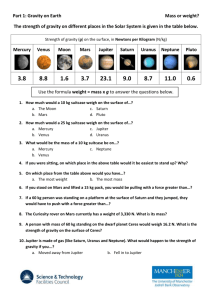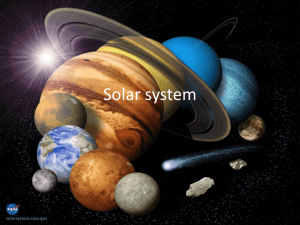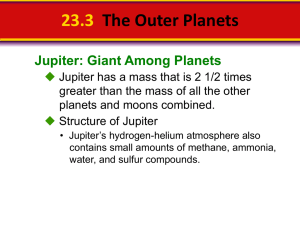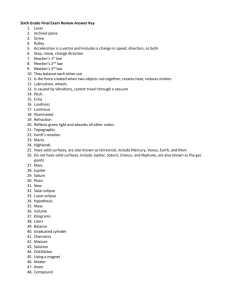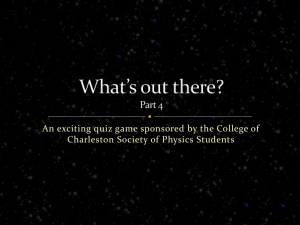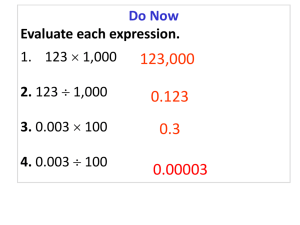Saturn's Ring - Solar Physics and Space Weather
advertisement
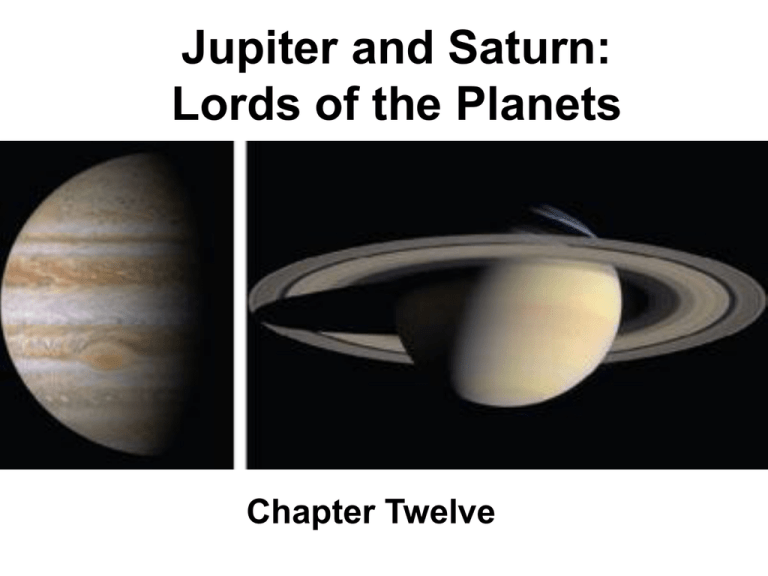
Jupiter and Saturn: Lords of the Planets Chapter Twelve ASTR 111 – 003 Lecture 11 Nov. 12, 2007 Fall 2007 Introduction To Modern Astronomy I: Solar System Introducing Astronomy (chap. 1-6) Planets and Moons (chap. 7-15) Sun and Life: Highlights (Chap. 16 & 28) Ch7: Comparative Planetology I Ch8: Comparative Planetology II Ch9: The Living Earth Ch10: Our Barren Moon Ch11: Mercury, Venus and Mars Ch12: Jupiter and Saturn Ch13: Satellites of Jupiter & Saturn Ch14: Uranus, Neptune and Beyond Ch15: Vagabonds of Solar System Jupiter Data Largest Planet Saturn Data Magnificent Rings Orbital Motion • Best viewed at opposition • Jupiter: orbital period ~12 years, distance 5.2 AU • Jupiter: moves across the zodiac at the rate of one constellation per year • Jupiter: synodic period ~ 13 months; oppositions of Jupiter occur at intervals of about 13 months • Saturn: orbital period ~30 years, distance 9.6 AU • Saturn’s oppositions occur at intervals of about one year and two weeks Apparent Views • The visible “surfaces” of Jupiter and Saturn are actually the tops of their clouds • The rapid rotation of the planets (~ 10 hours) twists the clouds into dark belts and light zones that run parallel to the equator • The Great Red Spot in Jupiter is a long-lived stable storm system that has lasted for at least 300 hundred years. Differential Rotation • Differential rotation for Jovian planets – Equatorial regions rotate faster than polar regions – Jupiter • The equatorial region rotates at 9 hours 50 minutes • The polar region rotates at 9 hours 55 minutes – Saturn • The equatorial region rotates at 10 hours 13 minutes • The polar region rotates at 10 hours 39 minutes • Solid rotation for terrestrial planets Atmosphere: Composition • Similar to that of the Sun, from the nebula • Jupiter’s atmosphere, by the number of molecules, is 86.2% hydrogen (H2), 13.6% helium (He), 0.2% methane (CH4), ammonia (NH3) and water vapor (H2O) • Saturn’s atmosphere, by the number of molecules, is 96.3% hydrogen (H2), 3.3% helium (He), 0.4% methane (CH4), ammonia (NH3) and water vapor (H2O) • Compared with Jupiter, Saturn has a serious helium deficiency in the atmosphere – At Saturn’s low temperature (-180°C at cloud-top), helium gas forms droplets and falls deeper into the planet – Jupiter’s temperature is relatively warmer (-108°C at cloud-top), helium does not yet form rain droplets. Atmosphere: Activity • Great Red Spot, Brown ovals and white ovals are storm systems with circular wind. • Different colors due to seeing clouds at different height having different temperature, e.g,. brown seeing deeper Jupiter’s Northern and Southern Atmosphere Atmosphere: Great Red Spot • The great red spot was first seen in 1664, but may be much older • It is larger than the size of the Earth • The spot rotates counterclockwise with a period of about 6 days – Winds on the north flow westward – Winds on the south flow eastward • The spot is red because it is made of clouds at relatively high altitude Atmosphere: Activity • Storm systems under development Jupiter’s new storm Gemini North Telescope Saturn’s new storm Cassini spacecraft, infrared Internal Heat • Weather patterns in Earth’s atmosphere are powered by sunlight • Weather patterns in Jupiter and Saturn are powered mainly by internal heat, as well as sunlight. • Jupiter emits twice as much energy as from Sunlight • The internal energy comes from the thermal energy left after the initial creation of planets • Because of the large size, Jupiter and Saturn has retained substantial thermal energy even after billions of years • As the result of the continuous heat flow from below, the temperature of the atmosphere increases with increasing depth, causing strong up-down convection. • Coupled with fast rotation, convection flows in the atmosphere create a global pattern of eastward and westward zonal winds, e.g, 500 km/s • Zonal wind changes direction at the boundary of light zones and dark belts. Internal Heat •The temperature of the atmospheres increases with increasing depth •Very steeper changes for Jupiter •The atmosphere may have three layers of clouds •Jupiter and Saturn have no solid surface Internal Heat •Dark belts are regions we can see into the atmosphere’s lower levels •Dark belts appear brighter in infrared images, thus warmer in temperature, and deeper in altitude •White zones and Great Red Spots are clouds at higher altitude, where temperature is lower. Galileo Probe •The mission continued for 58 minutes •The probe reached 200 km below the Jupiter’s upper cloud layer •At this depth, temperature has increased to 152°C, and pressure to 24 ATM •Constant wind at 650 km/s throughout the descent, indicating the energy source is internal heat instead solar heating. Galileo’s Probe Enters Jupiter’s Atmosphere Dec. 7, 1995 (Artist’s Impression) Interior: Oblateness and cores • Oblateness: sphere is flattened at the pole • Jupiter: oblateness 6.5% – Diameter across the equator is 6.5% larger than its diameter from pole to pole. • Saturn: oblateness 9.8% • Earth: 0.3% • The oblateness depends on (1) planet’s rotation rate and (2) the mass distribution over its volume, which can be used to infer the properties of the core Interior: Oblateness and cores • Jupiter has a rocky inner core • It is surrounded by an outer core of liquid “ices” (water, ammonia, methane) • A thick mantle of helium and liquid metallic hydrogen • An outermost gas layer composed primarily of ordinary hydrogen and helium • Saturn’s internal structure is similar to that of Jupiter, but its core makes up a larger fraction of its volume and its liquid metallic hydrogen mantle is shallower than that of Jupiter Magnetic Field and Metallic Hydrogen • Jupiter and Saturn have strong magnetic fields, which should be generated by motion of an electrically conducting fluids in the interior • Liquid metallic hydrogen, instead of liquid iron (in the Earth), plays the role – hydrogen becomes a liquid metal when pressure exceeds 1.4 million atmosphere Aurorae on Jupiter and Saturn. Caused by charged particles from the magnetosphere funneled onto the planet’s magnetic poles. Saturn’s Rings • Saturn is circled by a system of thin, broad rings lying in the plane of the planet’s equator • Largest rings in the system: A ring, B ring, and C ring • Cassini division is a gap of 4500 km separating A and B ring Saturn’s System of Rings (Voyager 1 image) Saturn’s Rings • The ring appears and disappears over years • The system is tilted away from the plane of Saturn’s orbit, which causes the rings to be seen at various angles by an Earth-based observer over the course of a Saturnian year • The ring disappears when seen edge-on Movie 1203001.mov Changing Appearance of Saturn’s Ring as Seen from Earth Saturn’s Rings: Roche Limit • Saturn’s rings could not be solid sheet of matter. – Gravitational tidal force would tear it apart – Tidal force tends to keep particles separate. • Roche limit: at this distance from a planet’s center, the disruptive tidal force is just as strong as the gravitational force between particles – Inside Roche limit, the tidal force overwhelms the gravitational force. Particles can not accrete to form a larger body. Instead, they tend to spread out into a ring around the planet – For a planet, Roche limit is ~ 2.4 R (planet radius) 12cc1.swf Movie: Roche Limit Saturn’s Ring: Composition • Saturn’s rings are composed of numerous particles • The ring particles are ice fragment or ice-coated rocks • These particles produced thousands of narrow, closely spaced ringlets • Inner particles move faster than outer particles, in complete agreement with Kepler’s third law • The particles are mostly 10 cm (snowball size) in size; ranging from 1 cm (pebble size) to 5 m cross (boulder size) Most of its rings exist inside the Roche limit of Saturn Saturn’s Rings • The rings are seen as sunlight is reflected by the icy ring particles • The ring pattern is affected by the gravitational effects of nearby moons. Final Notes on Chap. 12 • There are 11 sections in total. • The following sections are not covered – 12-11 (satellites affect the structure of the ring) Advanced Question Chap. 12, Q36 in P326 Jupiter was at oppositon on June 5, 2007. On that date Jupiter appeared to be in constellation Ophiuchus. Approximately when will Jupiter next be at opposition in this same region of the celetial sphere? Explain your answer?

